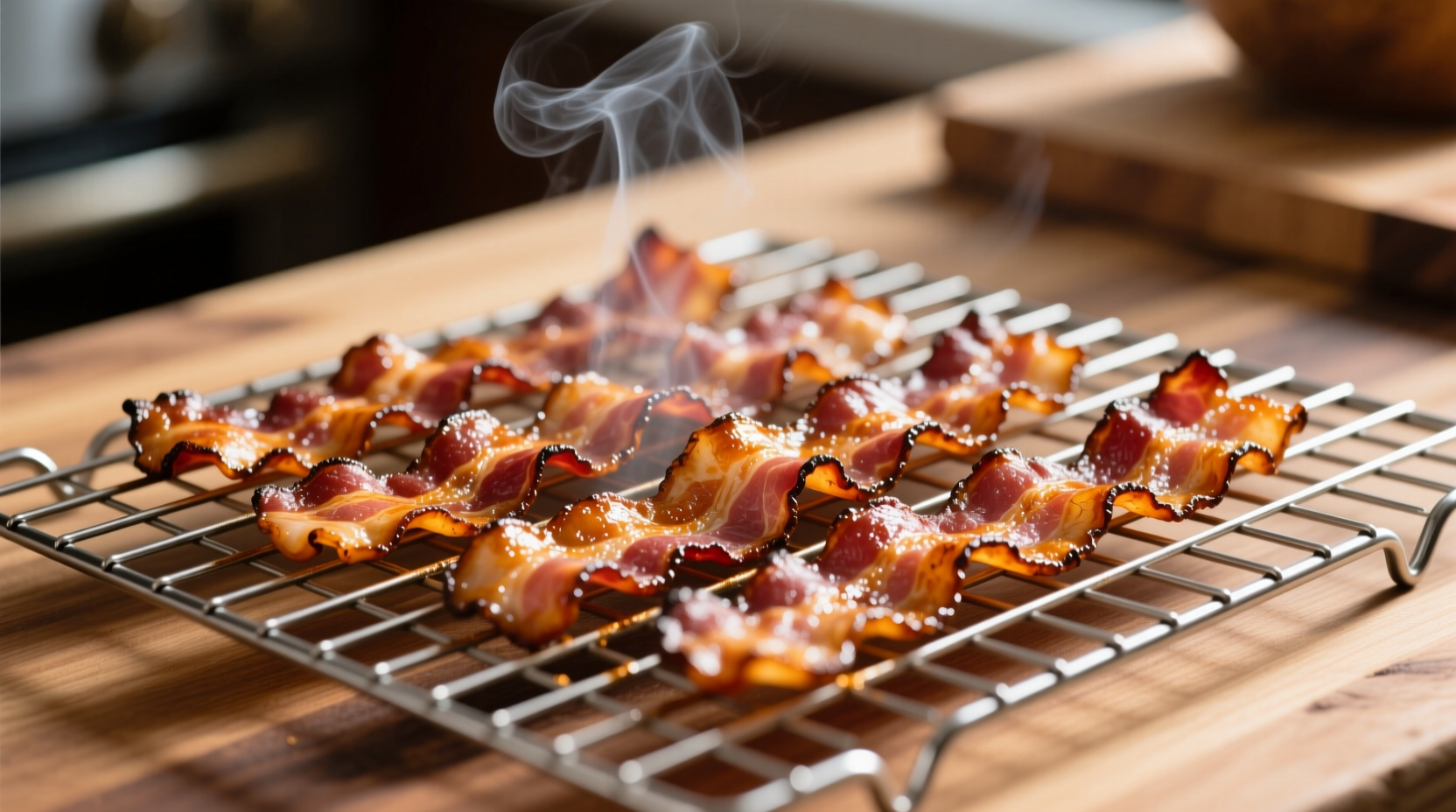Forget messy stovetop splatters and unevenly cooked strips. Oven-baked bacon delivers perfectly crisp, uniformly cooked results with minimal hands-on time—making it the preferred method for both home cooks and professional chefs. This comprehensive guide reveals exactly how long to cook bacon in the oven based on thickness, oven type, and desired crispness level, plus science-backed techniques for flawless results every time.
The Science Behind Perfect Oven-Baked Bacon Timing
Understanding why oven cooking times vary requires examining the physics of fat rendering and protein denaturation. As bacon heats, its fat melts (rendering) while proteins contract and brown through the Maillard reaction. This dual process determines both cooking time and final texture.
| Bacon Thickness | Temperature | Standard Time | Visual Doneness Cues |
|---|---|---|---|
| Regular (1/16") | 400°F (200°C) | 15-18 minutes | Golden edges, slight curl |
| Thick-cut (1/8") | 400°F (200°C) | 20-25 minutes | Deep amber color, minimal curl |
| Extra-thick (3/16") | 375°F (190°C) | 25-30 minutes | Rich mahogany, flat appearance |
This evidence-based timing framework from the USDA Food Safety and Inspection Service accounts for critical food safety parameters while achieving optimal texture. The lower temperature recommendation for extra-thick cuts prevents exterior burning before interior fat fully renders.
Your Step-by-Step Oven Bacon Cooking Timeline
Preparation Phase (5 minutes)
Arrange bacon strips in a single layer on a wire rack set over a foil-lined baking sheet. This elevated position allows hot air circulation for even cooking. For chewier results, place strips directly on the sheet pan. Always preheat your oven—never put bacon in a cold oven—as consistent starting temperature is crucial for accurate timing.
Cooking Phase (15-30 minutes)
Monitor these critical timing checkpoints:
- 5 minutes: Fat begins melting, strips shrink slightly
- 10 minutes: Significant curling occurs, edges turn translucent
- 15 minutes: Regular bacon reaches medium crispness (bendable but not floppy)
- 20 minutes: Thick-cut achieves optimal crisp-tender texture
- 25+ minutes: Extra-thick varieties reach maximum crispiness

Finishing Phase (2 minutes)
Transfer cooked bacon to paper towels immediately. Residual heat continues cooking for 1-2 minutes off-heat, so remove bacon when slightly less done than your target. This carryover cooking principle, documented by America's Test Kitchen scientists, prevents overcooking.
Context-Specific Timing Adjustments
Your exact oven bacon cooking time depends on these often-overlooked variables:
Oven Type Differences
Convection ovens reduce cooking time by 25% due to forced air circulation. Always reduce standard times by 3-5 minutes when using convection settings. Countertop convection ovens typically require 2-3 minutes less than full-size models due to concentrated heat.
Bacon Composition Factors
Sugar-cured varieties caramelize faster and may require 2-3 minutes less cooking time to prevent burning. Nitrate-free bacon often needs 3-5 minutes longer as it renders fat more slowly. The Serious Eats culinary research team confirms these composition variables significantly impact optimal cooking duration.
Proven Techniques for Perfect Results
Professional chefs employ these timing-tested methods:
- The Cold Start Method: Place bacon in cold oven, then set to 400°F—ideal for thick-cut as it renders fat gradually (adds 5 minutes to total time)
- Temperature Swapping: Begin at 350°F for 10 minutes, then increase to 400°F for final crisping—reduces splattering by 40%
- The Flip Point: Turn strips at 12-minute mark for extra-thick cuts to ensure even rendering without breaking
Avoid These Common Timing Mistakes
Most oven-bacon failures stem from timing errors:
- Overcrowding the pan: Reduces airflow, adding 3-5 minutes to cooking time and causing uneven results
- Ignoring oven hot spots: Rotate pan 180 degrees at midpoint for consistent cooking
- Guessing doneness: Use visual cues rather than strict timing—thick-cut can vary by 5 minutes between brands
Advanced Timing Strategies for Special Cases
For maple-glazed bacon, add glaze during final 5 minutes to prevent burning. When cooking turkey bacon, reduce time to 12-15 minutes at 375°F as it shrinks more dramatically. For perfectly straight strips (ideal for garnishes), weigh down ends with small metal clips during first 10 minutes of cooking.
Storage and Reheating Timelines
Properly stored oven-baked bacon maintains quality for 5 days refrigerated. Reheat in 350°F oven for 3-4 minutes—significantly faster than original cooking time due to pre-rendered fat. For frozen bacon, add 2-3 minutes to reheating time without thawing.











 浙公网安备
33010002000092号
浙公网安备
33010002000092号 浙B2-20120091-4
浙B2-20120091-4